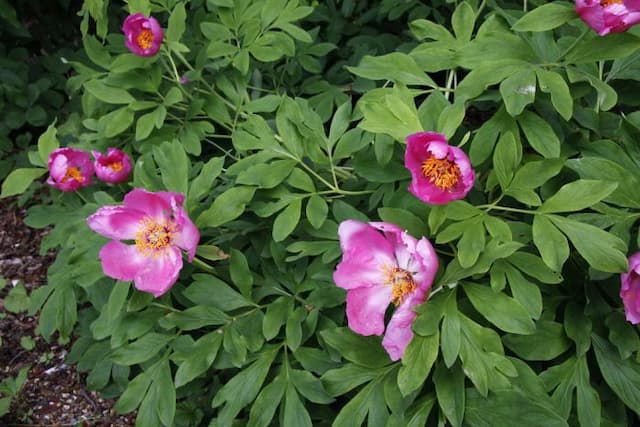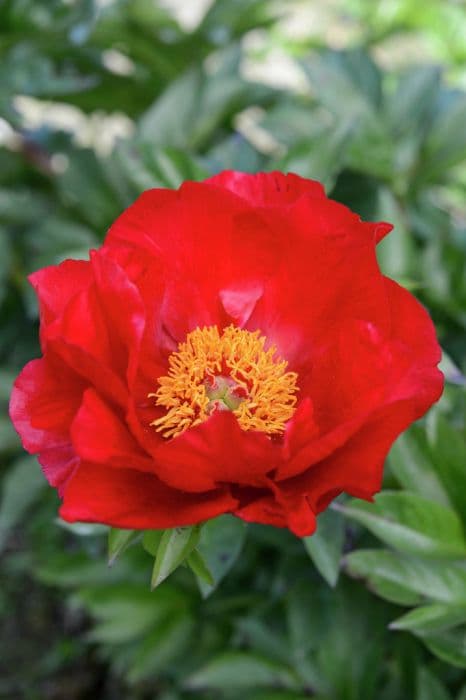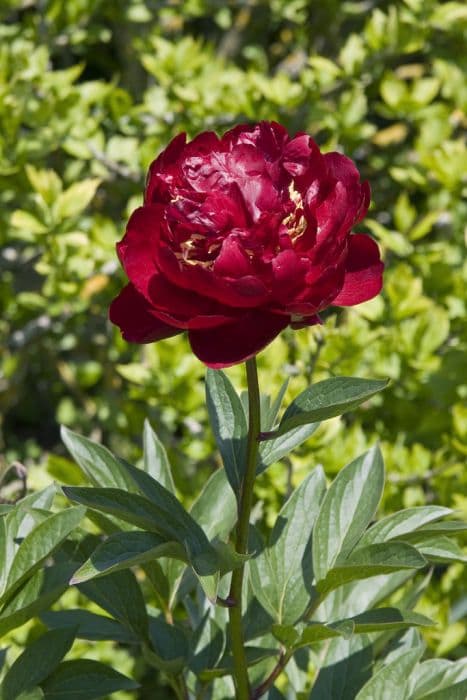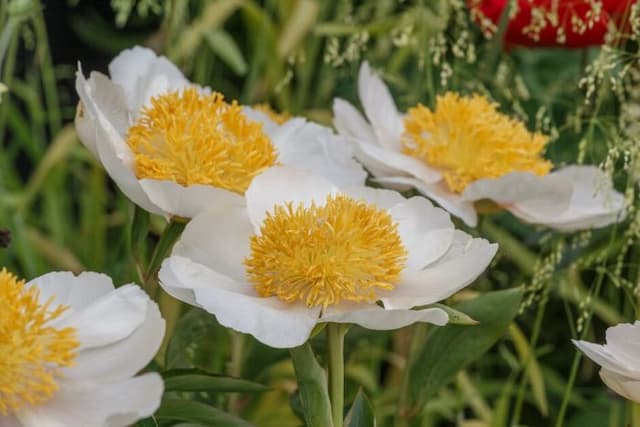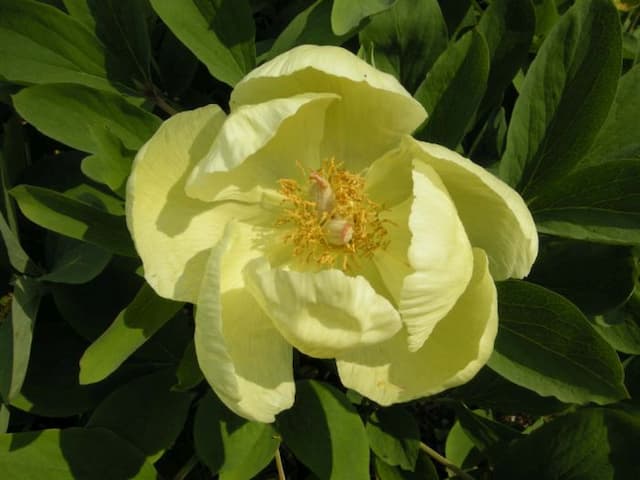Ludlow's Tree Peony Paeonia ludlowii (S)

ABOUT
Paeonia ludlowii, commonly known as the Tibetan peony, is a perennial bush recognized for its striking appearance. The plant sports large, glossy, deep green leaves that provide a lush backdrop to its eye-catching blooms. These flowers are particularly remarkable, appearing as large, solitary cups with an alluring, rich yellow hue. The petals are broad, rounded, and slightly ruffled, often exuding an attractive sheen as they catch the light. At the center of each flower sits a conspicuous cluster of stamens, which are thread-like and crowned with prominent anthers that contribute to the plant's ornamental appeal. These stamens surround the central carpels, which are usually green or red and add to the visual interest of the bloom. The Tibetan peony's blossoms emit a subtle, pleasing fragrance that draws in both garden admirers and pollinators alike. After the flowering season, the plant produces seed pods that are also visually intriguing, showcasing the cycle of growth and renewal in the garden landscape. The foliage of the Tibetan peony changes with the seasons, remaining lush and vibrant throughout the growing period before turning to attractive hues in the fall, signaling the plant's preparation for the dormant winter months. Overall, the Tibetan peony is admired for its showy blooms, pleasant aroma, and the dynamic change in foliage color, which together create a stunning display in any suitable garden setting.
About this plant
 Names
NamesFamily
Paeoniaceae
Synonyms
Ludlow's Tree Peony, Tibetan Tree Peony
Common names
Paeonia ludlowii.
 Toxicity
ToxicityTo humans
Paeonia ludlowii, commonly known as Tree Peony, is not considered highly toxic to humans. However, it can cause mild to moderate gastrointestinal upset if ingested in large quantities. This can include symptoms such as nausea, vomiting, and diarrhea. Care should be taken, particularly with children and individuals with sensitive systems, to avoid the ingestion of parts of this plant.
To pets
Paeonia ludlowii, also known as Tree Peony, can be toxic to pets if ingested. Similar to the toxicity in humans, consumption of the plant, particularly in large amounts, can lead to gastrointestinal upset in pets. The symptoms of poisoning might include nausea, vomiting, diarrhea, and rarely, more severe symptoms if a substantial amount has been consumed. Pet owners should keep their animals clear of this plant to prevent any accidental ingestion.
 Characteristics
CharacteristicsLife cycle
Perennials
Foliage type
Deciduous
Color of leaves
Green
Flower color
Yellow
Height
6 feet (1.8 meters)
Spread
4 feet (1.2 meters)
Plant type
Shrub
Hardiness zones
6
Native area
Tibet
Benefits
 General Benefits
General Benefits- Ornamental Value: Paeonia ludlowii, commonly known as the Tibetan peony, has large, bright yellow flowers that add aesthetic value to gardens and landscapes.
- Pollinator Attraction: The vibrant blooms attract bees and other pollinators, supporting local ecosystems.
- Cultural Significance: Peonies in general have a rich cultural heritage, particularly in Asia, where they are symbols of prosperity and honor.
- Durability: Tibetan peonies are known for their hardiness, capable of withstanding colder climates and less-than-ideal soil conditions.
- Long Lifespan: With proper care, peonies can live for several decades, providing long-lasting beauty in gardens.
- Minimal Maintenance: Once established, peonies require relatively low maintenance compared to other garden plants.
- Seasonal Interest: Their springtime blooms provide a visual signal of the changing seasons.
- Character Growth: Over the years, Paeonia ludlowii can grow into a substantial shrub, adding structure and character to garden spaces.
 Medical Properties
Medical Properties- Anti-inflammatory: Paeonia ludlowii may possess compounds that help reduce inflammation.
- Immunomodulatory: There could be elements within the plant that modulate the immune system.
- Antioxidant: The plant might contain antioxidants that help protect cells from damage caused by free radicals.
 Air-purifying Qualities
Air-purifying QualitiesThis plant is not specifically known for air purifying qualities.
 Other Uses
Other Uses- Ludlow's tree peony (Paeonia ludlowii) petals can be used for natural fabric dyeing, providing a range of colors from soft pinks to rich yellows depending on the mordant used.
- The fallen petals of the plant can be added to compost as a source of nutrients and organic matter.
- Ludlow's tree peony branches could be used in decorative woodworking or incorporated into creative art projects as they have a uniquely patterned grain.
- The seeds of Paeonia ludlowii may be pressed to extract oil for use in eco-friendly paints and varnishes.
- Dried Paeonia ludlowii leaves can serve as a natural potpourri, emitting a subtle fragrance for home scenting.
- The plant can be used as a natural insect repellent, with its fragrance discouraging certain garden pests.
- Ludlow's tree peony can be integral in garden design, functioning as a natural privacy screen when planted in rows or clusters.
- The fibrous roots of Paeonia ludlowii can be examined for their potential in creating sustainable non-woven textiles.
- The sturdy stems can be harvested and utilized as natural stakes or supports for other plants in the garden.
- Paeonia ludlowii leaves can contribute to the crafting of eco-friendly paper or biodegradable leaf plates, demonstrating an unconventional use of the plant's byproducts.
Interesting Facts
 Feng Shui
Feng ShuiThe tree peony is not used in Feng Shui practice.
 Zodiac Sign Compitability
Zodiac Sign CompitabilityThe tree peony is not used in astrology practice.
 Plant Symbolism
Plant Symbolism- Prosperity: In many cultures, peonies symbolize wealth and good fortune, and Paeonia ludlowii is no exception. It's often considered a good omen for financial success.
- Romance: Peonies in general are commonly associated with romance and romantic love, possibly owing to their full, lush blooms.
- Beauty: The attractive appearance of the Tibetan peony's large, yellow flowers makes it a symbol of beauty and elegance.
- Honor: Peonies often represent honor and high esteem. Having Paeonia ludlowii in a garden might be seen as a nod to these values.
- Compassion: With its nurturing growth habit and showy flowers, the peony can signify compassion and care.
 Water
WaterTibetan peony requires regular watering to maintain moist but not waterlogged soil, especially during its growing season in spring and early summer. It's advisable to water once every week with approximately 1 to 2 gallons, depending on the climate and weather conditions. This plant does not tolerate drought well, so in particularly dry periods, you may need to water more frequently. During the winter, when the plant is dormant, you should reduce watering to prevent root rot. Always check the top inch of soil for dryness before watering again.
 Light
LightTibetan peony thrives best in full sun to partial shade. It should be planted in a spot where it can receive at least six hours of sunlight every day. However, in hotter climates, some afternoon shade can be beneficial to protect the plant from intense heat.
 Temperature
TemperatureTibetan peony can tolerate a range of temperatures, but it prefers temperate conditions. The ideal temperature range for this plant is between 65°F and 75°F. It is hardy and can survive temperatures as low as -20°F and as high as 85°F.
 Pruning
PruningTibetan peony should be pruned to remove spent flowers and dead or damaged wood, which encourages healthy growth and flowering. The best time to prune is in the fall after the leaves have died back or in early spring before new growth starts. Prune annually to maintain plant health and appearance.
 Cleaning
CleaningAs needed
 Soil
SoilTibetan peony prefers well-drained, fertile soil with a neutral to slightly alkaline pH, typically around 7.0. A good mix would be equal parts garden soil, compost, and perlite or sand to ensure proper drainage and fertility.
 Repotting
RepottingTibetan peony is usually not repotted often as it prefers to be left undisturbed. Repotting is typically done every 3 to 5 years or when the plant has outgrown its current container.
 Humidity & Misting
Humidity & MistingTibetan peony thrives best in moderate humidity levels but is quite adaptable and can tolerate the dry air.
 Suitable locations
Suitable locationsIndoor
Provide bright light, cool temps; not ideal for indoor growth.
Outdoor
Plant in full sun, well-draining soil, water regularly.
Hardiness zone
5-8 USDA.
 Life cycle
Life cyclePaeonia ludlowii, commonly known as Ludlow's Tree Peony, begins its life cycle as a seed that will undergo a period of stratification before germination, requiring a cold period to break dormancy. Once germinated, the seedling will establish its root system and begin to produce its first leaves, eventually forming a small plant. As a perennial, once established, it enters a yearly cycle of growth where it develops large, lobed leaves and a woody stem, with the plant dying back to the ground in winter and re-sprouting from the base in spring. Flowering occurs typically in late spring or early summer, producing large yellow blooms that are attractive to various pollinators. After pollination, the plant develops follicles that disperse seeds, continuing the life cycle. The plant can also expand vegetatively through new shoots arising around the base of the mature plant.
 Propogation
PropogationPropogation time
Spring
Paeonia ludlowii, commonly known as Ludlow's Tree Peony, can most popularly be propagated through division, which is best done in the fall. When the plant is dormant, carefully lift the clump from the ground and use a sharp knife or spade to divide the root ball into sections, ensuring that each section contains at least one eye or bud. These sections are then replanted in well-draining soil, ideally with some addition of compost to encourage healthy growth. It's important to plant the divisions at the correct depth, with the eyes situated no more than 2 inches (about 5 centimeters) below the soil surface. Water the new plants thoroughly and maintain consistent moisture as they establish themselves in their new location.
